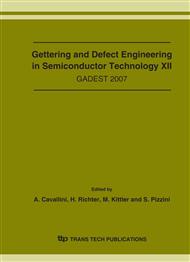p.167
p.175
p.183
p.189
p.195
p.201
p.207
p.213
p.219
SEM Investigation of Surface Defects Arising at the Formation of a Buried Nitrogen-Containing Layer in Silicon
Abstract:
The main goal of this work is to demonstrate the correlation between the density and type of surface defects arising during the formation of a buried nitrogen-containing layer in Si wafers, and the number of buried defects formed by different dose hydrogen preimplantation. Standard commercial 12 ⋅cm boron-doped and 4.5 ⋅cm phosphorous-doped Cz Si wafers were subjected to hydrogen ion implantation at room temperature with the energy 100 keV and doses 1⋅1015 - 4⋅1016 at/cm2. Then nitrogen was introduced into silicon from a DC plasma source at a temperature of 300 oС. Finally, all samples were subjected to 2 h vacuum annealing at 900 oС. The experiments have shown that the density and type of the surface defects depend significantly on the dose of hydrogen implantation, parameters of N+-plasma treatment, and conductivity type of silicon. Optimization of the above-mentioned parameters makes it possible to create the substrates containing a buried dielectric SixNy layer and having a practically defect-free surface.
Info:
Periodical:
Pages:
195-200
Citation:
Online since:
October 2007
Keywords:
Price:
Сopyright:
© 2008 Trans Tech Publications Ltd. All Rights Reserved
Share:
Citation:


